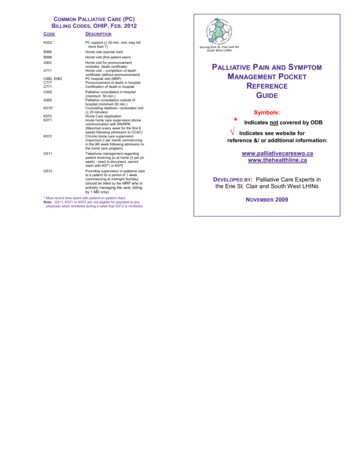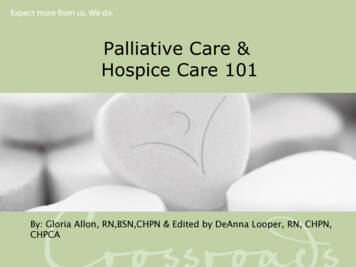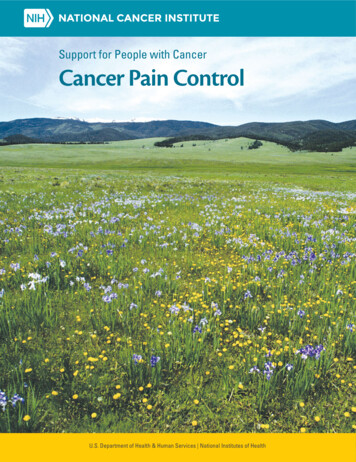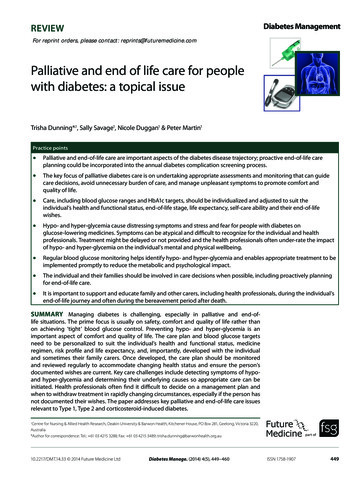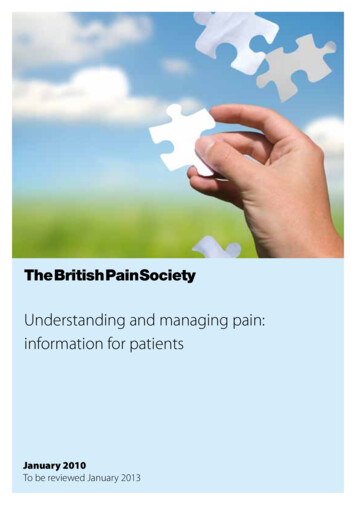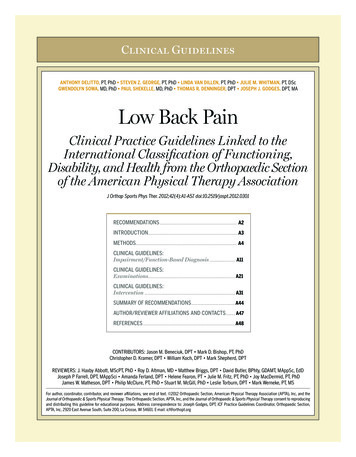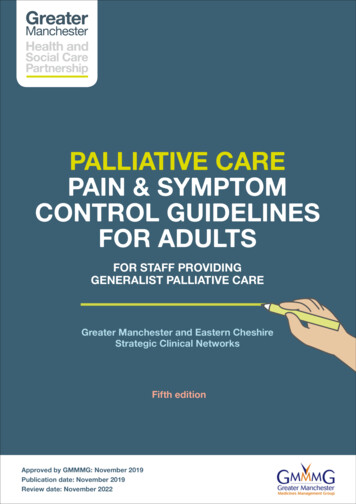
Transcription
PALLIATIVE CARE PAIN & SYMPTOM CONTROL GUIDELINES FOR ADULTS1PALLIATIVE CAREPAIN & SYMPTOMCONTROL GUIDELINESFOR ADULTSFOR STAFF PROVIDINGGENERALIST PALLIATIVE CAREGreater Manchester and Eastern CheshireStrategic Clinical NetworksFifth editionApproved by GMMMG: November 2019Publication date: November 2019Review date: November 2022
2PALLIATIVE CARE PAIN & SYMPTOM CONTROL GUIDELINES FOR ADULTSCONTENTSINTRODUCTION4GENERAL PRINCIPLES OF SYMPTOMMANAGEMENT IN PALLIATIVE CARE5SECTION 1 – SPECIFIC SYMPTOMSPAIN MANAGEMENT¡ Pain assessment9¡ Pain management – general points11¡ WHO Analgesic Ladder11¡ Alternative strong opioids19¡ Management of opioid side effects26¡ Use of naloxone27¡ Adjuvant analgesics29NAUSEA AND VOMITING32GASTRO-INTESTINAL REXIA45BREATHLESSNESS46COUGH50RESPIRATORY SECRETIONS52ORAL PROBLEMS53HICCUPS56DELIRIUM AND CONFUSION58ANXIETY61DEPRESSION64
PALLIATIVE CARE PAIN & SYMPTOM CONTROL GUIDELINES FOR ADULTSINSOMNIA66PALLIATIVE CARE EMERGENCIES¡ Neutropenic Sepsis67¡ Hypercalcaemia67¡ Superior vena cava obstruction69¡ Metastatic spinal cord compression70¡ Cauda Equina Compression71¡ Catastrophic haemorrhageCORTICOSTEROIDS103¡ Algorithm 3 – Patient taking regularoral oxycodone becomes unable toswallow104¡ Algorithm 4 – Patient using fentanyl orbuprenorphine patches becomes105unable to swallow7210674¡ Algorithm 6 – Respiratory tractsecretions107¡ Algorithm 7 – Breathlessness108¡ Algorithm 8 – Nausea and/orvomiting109¡ Algorithm 9 – Patient taking oralanti-epileptics for seizures orseizure prophylaxis110RENAL IMPAIRMENT79DIABETES8486SYMPTOM MANAGEMENT IN END OF LIFE88CARE FOR PEOPLE WITH DEMENTIASECTION 3 - CARE OF THE DYINGPRIORITIES FOR CARE OF THEDYING PERSON93SYMPTOM MANAGEMENT94MAINTAINING HYDRATION96SYRINGE PUMPS98ALGORITHMS FOR SYMPTOM MANAGEMENTIN THE LAST DAYS OF LIFE¡ Algorithm 1 – Patient not alreadyon strong opioids becomesunable to swallow¡ Algorithm 2 – Patient taking regularoral morphine becomes unableto swallow¡ Algorithm 5 – Terminal restlessnessand/or agitationSECTION 2 – SPECIFIC SITUATIONSMANAGEMENT OF IMPLANTABLECARDIOVERTER DEFIBRILLATORS3102SECTION 4 – APPENDICESAPPENDIX 1 - OPIOID CONVERSIONCHARTS112APPENDIX 2 - GENERAL PRINCIPLES ANDRESPONSIBILITIES WHEN ASKINGFOR ADVICE ABOUT PALLIATIVE CARE117PATIENTSAPPENDIX 3 - SPECIALIST MEDICATIONPRESCRIBING IN PALLIATIVE ANDSUPPORTIVE CARE120SECTION 5 - REFERENCES ANDABBREVIATIONSKEY REFERENCES123ABBREVIATIONS124
4PALLIATIVE CARE PAIN & SYMPTOM CONTROL GUIDELINES FOR ADULTSINTRODUCTIONThis is the fifth edition of the Greater Manchester and Eastern CheshireStrategic Clinical Networks Palliative Care Pain and Symptom ControlGuidelines. The level of detail provided is designed to meet the needsof generalist staff caring for palliative care patients in all settings i.e.hospital, community and care homes. Those working in SpecialistPalliative Care are advised to consult the Palliative Care Formulary6th Edition (PCF6) and local specialist guidelines for more detailedsymptom management information.The guidelines cover the management ofparticular symptoms and situations whichpalliative care patients may experience, as wellas end of life care for patients with an advancedprogressive illness. They should be used inconjunction with other national and regionalformularies and guidelines, for example:¡ British National Formulary (BNF).¡ Greater Manchester Medicines ManagementGroup Formulary or Central and EasternCheshire Medicines Management TeamFormulary.¡ Relevant National Institute for Health andCare Excellence (NICE) guidance.
PALLIATIVE CARE PAIN & SYMPTOM CONTROL GUIDELINES FOR ADULTS5GENERAL PRINCIPLES OF SYMPTOMMANAGEMENT IN PALLIATIVE CAREGood palliative care is not just about supporting someone in the lastmonths, days and hours of life, but about enhancing the quality oflife for patients and those close to them at every stage of the diseaseprocess from diagnosis onwards. A palliative care approach shouldbe considered alongside active disease management from an earlystage in the disease process. Palliative care focuses on the person, notthe disease, and applies a holistic approach to meeting the physical,practical, functional, social, emotional and spiritual needs of patientsand carers facing progressive illness and bereavement.The guidelines provide information about thegeneral approach to managing a symptom orsituation. However, management must beindividualised according to the needs of theparticular patient.Effective symptom management includes:¡ Evaluation – e.g. the cause of the symptom,its impact on the patient’s life and thetreatments tried already.¡ Explanation – to the patient and those closeto them about the cause of the symptom andoptions for treating it.¡ Management – individualised to theparticular patient. Treat any reversible causes,use non-drug treatments where available,keep drug treatment as simple as possible,seek advice when necessary.¡ Monitoring – review the impact of treatmentregularly, paying attention to detail.(Ref: Scottish Palliative Care Guidelines,Symptom Management in Advanced Cancer)SEEKING SPECIALIST ADVICEThroughout the guidelines there arenumerous recommendations to seekspecialist advice. For advice or furtherinformation, please contact your localhospice or Specialist Palliative Care Team.Use of medications outside their marketingauthorisation (formerly known as productlicence).Many drugs are used in palliative care outsidetheir marketing authorisation at the prescriber’sdiscretion. The inclusion of a drug, dose ortreatment in these guidelines does not absolvethe prescriber of their personal responsibility inproviding treatment that they are confident with,can justify and that is tailored to the individualpatient. For details of authorised indications seethe current BNF.
6PALLIATIVE CARE PAIN & SYMPTOM CONTROL GUIDELINES FOR ADULTSContributors to this edition:Dr Aruna HodgsonClinical Lead, Greater Manchester and Eastern Cheshire StrategicClinical Networks Palliative Care Pain and Symptom ControlGuidelines Update Task and Finish GroupDr Debbie AlexanderMedical Director, East Cheshire HospiceDr Stephanie LippettSenior Hospice Dr (Community), Springhill HospiceElaine ParkinQuality Improvement Programme Manager, Palliative and End of LifeCare, Greater Manchester and Eastern Cheshire Strategic ClinicalNetworksJennie PickardPalliative Care Pharmacist, St Ann’s Hospice, Heald Green andManchester University NHS Foundation TrustAnna SwiftSenior Assistant Director Medicines Management, NHS WiganBorough Clinical Commissioning GroupDr David WatermanPalliative and End of Life Care Clinical Lead, Greater Manchester andEastern Cheshire Strategic Clinical NetworksAuthorised by:Greater Manchester and Eastern Cheshire Strategic Clinical NetworksPalliative and End of Life Care Advisory Group.Acknowledgements:All colleagues working in Specialist Palliative Care who have contributed toprevious editions of the guidance.
PALLIATIVE CARE PAIN & SYMPTOM CONTROL GUIDELINES FOR ADULTS7
8PALLIATIVE CARE PAIN & SYMPTOM CONTROL GUIDELINES FOR ADULTSSECTION 1SPECIFICSYMPTOMS
PALLIATIVE CARE PAIN & SYMPTOM CONTROL GUIDELINES FOR ADULTS9PAIN1. Pain assessment¡ Good assessment is vital for effective management.¡ Many palliative care patients have more than one pain.¡ Assess each pain separately and if possible identify the likely cause of the pain.¡ Pain may be constant or intermittent (breakthrough pain).Ask about: site and radiation - a body diagram canhelp character - a list of descriptive words mayhelp onset, intensity and severity - a rating scalecan help e.g. a numerical score where 0 no pain and 10 severe/overwhelming ora simple verbal rating scale – none/mild/moderate/severe timing and duration exacerbating factors relieving factors, including medication effect on function, sleep and mood response to previous medication andtreatment associated symptoms.¡ Consider using a structured pain assessmenttool to record the patient’s pain.¡ Examine the patient to try and determine thecause of the pain(s), e.g. abnormal sensation,tender hepatomegaly.¡ Assess the impact of the pain on the patientand family. Consider if other factors, such asemotional, psychological or spiritual distress,are having an effect on pain perception.¡ Consider appropriate investigations to try anddetermine the cause of the pain.Common causes of pain¡ Disease related: direct invasion by cancer,distension of an organ, pressure onsurrounding structures: bone pain: worse on pressure or stressingbone or weight bearing nerve pain: burning, shooting, tingling,jagging, altered sensation, dermatomaldistribution spinal cord compression: back or spinalpain in a radicular “band-like” pattern liver pain: hepatomegaly, right upperquadrant tenderness, referred pain inshoulder tip raised intracranial pressure: headache,nausea or both, often worse in the morningor with lying down colic: intermittent cramping pain. Considerbowel obstruction, bladder spasm.¡ Treatment-related: chemotherapyneuropathy, constipation due to opioids,radiation-induced mucositis.¡ Debility: pressure sores, severe cachexia,oral candidiasis.¡ Other unrelated illnesses: arthritis,osteoporosis, vascular disease, gastritis.(Ref: Scottish Palliative Care Guidelines)
10PALLIATIVE CARE PAIN & SYMPTOM CONTROL GUIDELINES FOR ADULTSTable 1: Common types of pain in palliative care patients and thicSmoothmusclespasmExamplesBonemetastasesLiver, derGnawing,aching.Worse onmoving orweight y;bisphosphonateSharp acheor deep,throbbing.Worse onbending orbreathing.WHOLadderCorticosteroidNSAIDsNerve ine;antiepileptic erve ;BonemetastasesBurning,shooting;sensorydisturbance inaffected areaBowelobstruction;BladderspasmDeep, twisting,colicky(waves)WHOLadderSNRIe.g. duloxetine;CorticosteroidMay besensitiveto opioid variableAnticholinergic- e.g. hyoscinebutylbromidefor bowel colicSurgical relief ofobstruction2. Pain management – general points¡ Set realistic goals, e.g. pain-free overnight/at rest/on movement.¡ Give patients and those close to them information and instructions about the pain and itsmanagement. Encourage them to take an active role in managing the pain.¡ Review pain control regularly.¡ Manage patient expectations regarding optimal pain management, as it may not beachievable for them to be pain-free at all times.¡ Consider checking renal and liver function before initiating analgesics, if no recent bloodresults are available.
PALLIATIVE CARE PAIN & SYMPTOM CONTROL GUIDELINES FOR ADULTS113. Pain management - the WHO Analgesic Ladder(Ref: WHO Guidelines for the Pharmacological and Radiotherapeutic Management of CancerPain In Adults and Adolescents, 2018)¡ The WHO analgesic ladder provides a general guide to pain management based on painseverity. However, it does not replace the need for individualised management based oncareful assessment of an individual patient’s pain.Figure 1: The WHO three-step analgesicladder with examplesStep 3STRONGOPIOID non-opioid adjuvantsStep 2WEAK OPIOID non-opioid adjuvantsStep 1NON-OPIOID adjuvantsPersistent or worsening painTable 2: Example of use of the WHO analgesic ladderPatient on no analgesics - mild painExample - Step 1Example - Step 2Example - Step 3Start regular paracetamol¡ usual dose 1g four times aday, but dose reduction isadvisable in many palliativecare patients (see detailsbelow)and/orNSAID e.g. ibuprofen, naproxenor celecoxibIf pain is persistent orworsening¡ stop paracetamol if nothelping pain¡ start codeine 30-60mg fourtimes a day regularly(Step 2 may be omitted – seedetails below)On maximum paracetamol andcodeine, persistent or worseningpain¡ stop paracetamol if nothelping pain¡ stop codeine¡ commence strong opioid e.g.oral morphine (see detailsbelow)Choice of initial analgesic should take into account the cause and severity of pain¡ For mild pain start at step 1.¡ For moderate pain start at step 2 or step 3 (See section below re weak opioids).¡ For severe pain, start at step 3.
12PALLIATIVE CARE PAIN & SYMPTOM CONTROL GUIDELINES FOR ADULTSTable 3: Principles of analgesic useBy mouthWhenever possible, analgesics should be given by mouth.By the clockDoses of analgesic should be given at the appropriate regular time intervals,depending on the preparation and its duration of action.For theindividualManagement of an individual patient’s pain requires careful assessment and adecision about appropriate treatment options.Withattention todetailThe first and last doses of the day should be linked to the patient’s waking time andbedtime. Ideally, the patient’s analgesic medicine regimen should be written out infull for patients and their families to work from and should include the names of themedicines, reasons for use, dosage and dosing intervals. Patients should be warnedabout possible adverse effects of each of the medicines they are being given.
PALLIATIVE CARE PAIN & SYMPTOM CONTROL GUIDELINES FOR ADULTS13WHO Analgesic Ladder Step 1 –Non-opioidsWHO Analgesic Ladder Step 2 Weak Opioids (Ref PCF6)(i) Paracetamol (Ref PCF6)There is no pharmacological need for weakopioids and moving directly from a non-opioidto a strong opioid is increasingly preferred inpalliative care. Morphine (or an alternative strongopioid) at low doses generally provides quickerand better relief from cancer pain than weakopioids.¡ Usual dosing – For patients without riskfactors for paracetamol hepatotoxicity, thestandard regimen is 1g four times a day.¡ For patients with more than one hepaticrisk factor (old age, weight less than50kg, poor nutritional status, fasting/anorexia, chronic alcohol use) – reduceddose of 500mg four times a day, increasedif necessary to a maximum of 3g per day individed doses, is advisable.¡ For patients with severe renal impairment(eGFR 10ml/min) – reduce dose (maximum3g/24hrs) (Ref PCF6). For further guidancesee section on Symptom Management inpatients with Renal Impairment(ii) NSAIDsNSAIDs are particularly useful when there is aninflammatory component to the pain. Optionsinclude:¡ Ibuprofen 200-400mg three times a day.¡ Naproxen 250-500mg twice daily may also beused.¡ Celecoxib 100mg twice daily, increased ifnecessary to 200mg twice daily (Ref: PCF6).For further guidance see section on AdjuvantAnalgesicsIf considering prescribing a weak opioid, beaware that:¡ Codeine has to be converted to morphine inthe body to achieve an analgesic effect. Poormetabolisers of codeine may not experienceanalgesia. Ultrarapid metabolisers mayexperience toxicity.¡ Dihydrocodeine is an active substance so itseffect is not dependent on metabolism.Also see Table 42 - Dose conversions of weakopioids to oral morphineWHO Analgesic Ladder Step 3 –Strong OpioidsMorphine is the strong opioid of choice formanagement of moderate to severe pain inpalliative care patients, based on familiarity,availability and cost. The oral route is preferredas long as the patient has no problems withswallowing or absorption.Other strong opioids are used mostly when:¡ Morphine is not readily available.¡ The patient has unacceptable side effectswith morphine.¡ The transdermal route is preferable.¡ The patient has severe renal impairment(Ref: NICE Guideline CG140 Palliative care foradults: strong opioids for pain relief, PCF6)
14PALLIATIVE CARE PAIN & SYMPTOM CONTROL GUIDELINES FOR ADULTSFactors to consider beforeprescribing strong opioids (Ref: PCF6)There are generally no absolute contraindications to the use of strong opioidsin palliative care patients with advancedprogressive disease, provided the dose istitrated carefully against the patient’s pain.However, for palliative care patients with alonger prognosis, the potential side effects oflong-term opioids and their limited effectivenessin chronic pain should be taken intoconsideration when deciding whether a strongopioid is the best treatment option. See Box 2- Management of long-term pain in palliativecare patients¡ products with different bioavailabilities thatare not interchangeable.Information to be given to patients and carers¡ When considering starting strong opioids,ask the patient and their carers about anyconcerns they may have about opioids e.g.addiction, tolerance, side effects, or fears thattreatment implies the final stages of life.Provide verbal and written informationincluding:¡ When and why strong opioids are used totreat pain.¡ How effective they are likely to be.¡ Taking strong opioids for background andbreakthrough pain, addressing:Due to reports of serious incidents and thepotential for toxicity with strong opioids,diligent prescribing, dispensing, administration,monitoring and counselling is required to reducethe risk of error and/or confusion, particularlybetween:¡ Side effects and signs of toxicity.¡ Immediate-release and modified-release¡ Safe storage.products.¡ Products with different durations of action,e.g. 12-hourly vs 24-hourly modified-releaseproducts, 7-day vs 3- or 4-day transdermalpatches.¡ Products with both low and high strengthconcentrates, e.g. oral solutions, injections. how, when and how often to take strongopioids how long pain relief should last.¡ Follow-up and further prescribing.¡ Information about who to contact outof hours, particularly during initiation oftreatment.¡ Information on strong opioids and driving (seeBox 1 below).Box 1 - Driving whilst taking strong opioids¡ Drivers are liable to prosecution if driving when impaired by drugs such as strong opioids,whether prescribed or illicit.¡ Warn patients not to drive when starting or titrating strong opioids and other potentially sedatingmedications, or after taking a dose of strong opioid for breakthrough pain.¡ Patients may drive when taking these medications once a stable dose is achieved, as long asthey are not affected by drowsiness and not impaired by the disease itself.¡ The police use roadside tests to look for illicit use of strong opioids and other drugs which mayimpair driving performance. Advise patients to carry evidence to confirm that the medicineshave been prescribed for them e.g. a repeat prescription. (Ref: PCF6)¡ See www.gov.uk/drug-driving-law for further information.
PALLIATIVE CARE PAIN & SYMPTOM CONTROL GUIDELINES FOR ADULTS15Box 2 - Management of long-term pain in palliative care patients1. Some patients with a palliative diagnosis have a long prognosis and may have pain for anumber of years. For such patients, consideration must be given to the potential long-termside effects of any treatments they may be given.2. There is particular concern about the use of opioids for chronic pain. The clinical evidenceshows limited effectiveness and patient safety concerns due to the risks associated with longterm use of opioids such as fractures and falls, endocrine abnormalities, immunomodulation,opioid induced hyperalgesia and dependence.3. Based on the clinical evidence Public Health England and the Faculty of Pain Medicine haveadvised:¡ Opioids are very good analgesics for acute pain and for pain at the end of life but there islittle evidence that they are helpful for long term pain.¡ A small proportion of people may obtain good pain relief with opioids in the long term if thedose can be kept low and especially if use is intermittent (however it is difficult to identifythese people at the point of initiation).¡ The risk of harm increases substantially at doses above an oral morphine equivalent of120mg/day, but there is no increased benefit.¡ If a patient is using opioids but is still in pain, the opioids are not effective and should bediscontinued, even if no other treatment is available.¡ Chronic pain is very complex and if patients have refractory and disabling symptoms,particularly if they are on high opioid doses, a very detailed assessment of the manyemotional influences on their pain is essential.3. Drug treatments:¡ Should be reserved for when non-pharmacological therapies alone have failed.¡ Should be given on a trial basis initially.¡ Should only be continued with good objective evidence of improved function (not just painperception).4. The BNF advises that the prescriber has three main responsibilities:¡ To avoid creating dependence by introducing drugs to patients without sufficient reason.¡ To see that the patient does not gradually increase the dose of a drug, given for goodmedical reasons, to the point where dependence becomes more likely.¡ To avoid being used as an unwitting source of supply for addicts and being vigilant tomethods for obtaining medicines.For further guidance, refer to the GMMMG Opioid Prescribing for Chronic Pain Resource -Resource-Pack-Approved-CSBAugust-2018.pdf or seek specialist advice.
16PALLIATIVE CARE PAIN & SYMPTOM CONTROL GUIDELINES FOR ADULTSCommencing oral morphine (Ref: PCF6)¡ Patients can be started on either animmediate-release or a modified-releasepreparation.¡ ALWAYS prescribe an immediate-releasemorphine preparation for breakthrough painwhen prescribing regular morphine.¡ The starting dose should usually becalculated to give a greater analgesic effectthan the medication already in use, taking intoaccount individual circumstances.¡ The patient must be monitored closely,including for side effects. See section onManagement of opioid side effects¡ Always prescribe laxatives alongside strongopioids (usually a stimulant laxative unlesscontra-indicated).¡ Depending on individual circumstances, anantiemetic should be prescribed for regular orp.r.n. use.Table 4 - Morphine preparations and recommended frequencyGeneric morphineDose intervalsImmediate-release oralmorphine10mg/5ml solution;10mg, 20mg, 50mg tablets4 hourlyImmediate-release morphineconcentrated oral solution*20mg/ml(only on specialist advice)4 hourlyModified-release oralmorphine(12 hourly preparations)5mg, 10mg, 15mg, 30mg,60mg, 100mg, 200mg tablets;10mg, 30mg, 60mg, 100mg,200mg capsules;20mg, 30mg, 60mg, 100mg,200mg granules12 hourlyModified-release oralmorphine(24 hourly preparation)30mg, 60mg, 90mg, 120mg,150mg capsules24 hourlyMorphine injection1mg/ml, 10mg/ml, 15mg/ml,30mg/ml*4 hourly as breakthroughdose or over 24 hourssubcutaneously via syringepumpMorphine brand namesRefer to BNF for brands currentlyavailable.In Primary Care – prescribemorphine preparations by brandname as modified-releasepreparations have differentrelease characteristics and patientfamiliarity with one brand isimportant in ensuring safety.(Ref: GMMMG GenericPrescribing Guidelines v.1)In hospitals and hospices –generic prescribing may be requiredif the unit does not stock the brandwhich the patient usually takes.*NB. Concentrated preparations of morphine must be used with caution, as there are significant risksof overdose if a concentrate product is used in error for a normal strength product.
PALLIATIVE CARE PAIN & SYMPTOM CONTROL GUIDELINES FOR ADULTSSuggested starting doses of oral morphine¡ Patient opioid-naïve (except in frail/elderly/renal impairment) – start oral morphine5mg immediate-release 4 hourly or modifiedrelease 15mg 12 hourly.¡ Patient opioid-naïve and frail/elderly – startoral morphine 2.5mg immediate-release 4hourly.¡ Patient previously receiving a regularweak opioid (e.g. codeine 240mg/24hor equivalent – see Appendix 1 – OpioidConversion charts ) - start oral morphine1710mg immediate-release 4 hourly ormodified-release 20–30mg 12 hourly, butless if suspected to be a poor metaboliser ofcodeine. In frail/elderly - use a lower startingdose of 5mg immediate-release 4 hourly ormodified-release 10-15mg 12 hourly.¡ Patient with severe renal impairment –morphine should be avoided if possible andan alternative strong opioid used instead see section on Symptom Management inPatients with Renal ImpairmentBox 3 - Management of breakthrough painBreakthrough pain may occur either as a result of a predictable event (incident pain) e.g. onmovement, or spontaneously without predictable precipitating factors. Some breakthroughpains are short-lived and resolve spontaneously, in which case the patient may not need to takebreakthrough analgesia.(i) Management of breakthrough pain other than incident pain¡ An immediate-release strong opioid should be prescribed 2-4 hourly when required, up toa maximum of 6 doses in 24 hours. Where possible, the regular and “when required” opioidshould be the same drug, e.g. morphine modified-release and immediate-release.¡ Doses are typically 1/10 to 1/6 of the total daily regular dose, but as with the regular dose,there is need to consider individual variation.Example – calculation of p.r.n. dose based on 1/6 of regular 24 hour dose Patient is taking morphine modified-release 30mg twice a day - the “when required” dose is60 divided by 6 10mg 4 hourly when required.¡ The “when required” dose should usually be increased when the regular dose is increased. If3 or more “when required” doses are needed per day, consider a review of pain management.Seek specialist advice if necessary.(ii) Management of incident pain¡ Where possible, a predictable painful activity should be timed to coincide with the peakplasma concentration after a regular or “when required” dose of morphine. For example,a dose of immediate-release strong opioid could be given at least 30 minutes before theprecipitant of the pain. If this is not effective, consider seeking specialist advice regardingalternative methods for managing incident pain.
18PALLIATIVE CARE PAIN & SYMPTOM CONTROL GUIDELINES FOR ADULTSTitrating oral morphine dose¡ When adjusting the dose of morphine, use of“when required” doses should be taken intoaccount.¡ Check with the patient that the morphine iseffective before increasing the dose.¡ Increments should not exceed 33-50% every24 hours.Examples of dose titration Immediate-release oral morphine:5 7.5 10 15mg 4 hourly. Modified-release oral morphine:10 15 20 30mg twice a day.¡ Upward titration of the dose of morphineshould stop when either the pain is relievedor unacceptable side effects occur. In thelatter case, switching to an alternative strongopioid should be considered(see page 19).¡ If the patient was commenced on regularimmediate-release morphine, once paincontrol is achieved consider conversion tomodified-release morphine at the same 24hour total dose.¡ Consider seeking specialist advice if: The dose of morphine has been titratedthree times without achieving pain control. The patient requires three or more “whenrequired” doses per day. The total daily dose of oral morphineexceeds 120mg over 24 hours. The patient is experiencing unacceptableside effects.When the oral route is not available (e.g.patient is vomiting or unable to swallow)¡ If analgesic requirements are stable consider initiating transdermal patches.See sections on Buprenorphine andFentanyl .¡ If analgesic requirements are unstable -consider initiating subcutaneous opioids (seebelow)(Ref: NICE Guideline CG140 Palliative care foradults: strong opioids for pain relief)SEEK SPECIALIST ADVICE IF NECESSARYInitiating subcutaneous opioids¡ Morphine is recommended as the firstline strong opioid for subcutaneous usefor patients, except for patients who havebeen taking oral oxycodone or those withsevere renal impairment .¡ If patient has constant pain, prescribemorphine as regular 4 hourly SC injections oras a 24-hour continuous infusion via a syringepump.Conversion from oral to SC morphine:¡ Oral morphine 5mg SC morphine 2.5mg.¡ However, wide inter-individual variation existsand each patient should be assessed on anindividual basis. See Appendix 1 – OpioidConversion Charts for further informationabout strong opioid conversions .¡ Breakthrough doses of 1/10 to 1/6 of theregular 24-hour dose of opioid should beprescribed 2-4 hourly SC when required.
PALLIATIVE CARE PAIN & SYMPTOM CONTROL GUIDELINES FOR ADULTS194. Alternative Strong OpioidsWhen morphine cannot be used, alternative strong opioids commonly used in palliative careinclude:¡ Oxycodone (oral or subcutaneous).¡ Buprenorphine (transdermal).¡ Fentanyl (transdermal).NB. The transdermal route is only suitable if analgesic requirements are stable.Box 4 - Opioid switchingExplicit guidance on switching opioids is difficult because both the reasons for switching and thepatient’s circumstances differ.Conversion ratios are an approximate guide only. Many variables will affect the conversion e.g.age, renal/hepatic function, concurrent medication, comorbidity, duration of opioid treatment,pharmacokinetics of drugs.Consider a dose reduction of 50% when switching between opioids especially if¡ Patient is on a high dose of opioid (e.g. morphine dose 1g/24h or equivalent).¡ Opioid dose has been escalated rapidly.¡ Patient is frail or elderly.¡ Patient is experiencing side effects from the current opioid.In such circumstances, “when required” doses can be used to make up any deficit while retitrating to a satisfactory dose of the new opioid.SEEK SPECIALIST ADVICE on the most appropriate alternative strong opioid and theappropriate conversion ratio.See Appendix 1 – Opioid Conversion Chartsfor further information.
20PALLIATIVE CARE PAIN & SYMPTOM CONTROL GUIDELINES FOR ADULTSOxycodone¡ Oxycodone is a strong opioid with similarproperties to morphine.¡ It is licensed for moderate to severe pain inpatients with cancer and post-operative painand for the treatment of severe pain requiringthe use of a strong opioid.Place in therapy¡ Moderate to severe pain with unacceptablelevel of side effects with morphine.¡ Breakthrough medication for patients usingfentanyl or buprenorphine patches who haveexperienced an unacceptable level of sideeffects with morphine.Cautions¡ Use cautiously
Table 1: Common types of pain in palliative care patients and suggested management 2. Pain management - general points ¡ Set realistic goals, e.g. pain-free overnight/at rest/on movement. ¡ Give patients and those close to them information and instructions about the pain and its management.
